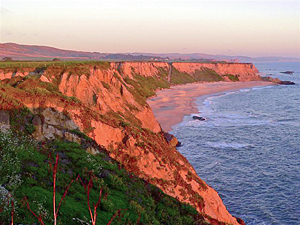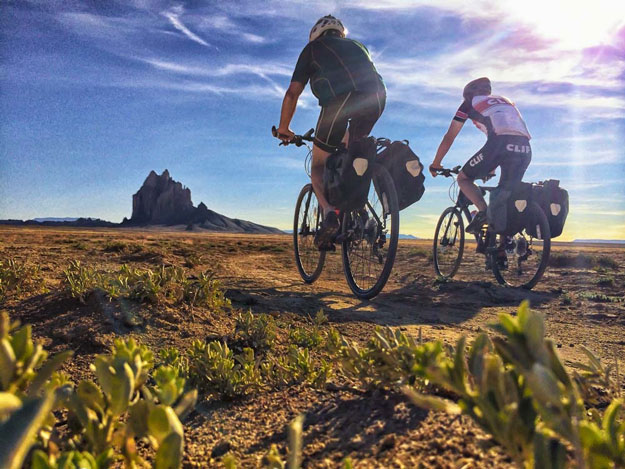- Tahoe’s Nevada Beach Tops the List of Hard-to-Book Campgrounds - 07/17/2024
- Cannabis Watershed Protection Program Cleans Up Illegal Grow Sites - 07/10/2024
- French Fire - 07/05/2024
Indian Summer is the ideal season for kayaking the coast, Lake Tahoe
By Pete Gauvin

Half Moon Bay Coastline
Photo: Lou Solitske
Push off from a sandy beach or paddle out of a protected harbor along the coast and you are physically no longer a resident of California, but of the eastern Pacific, at the edge of a vast wilderness.
September and October are usually the best months to explore this wilderness along our ruggedly beautiful coast. The fog layer loosens its grip and peels back to sea, while ocean swells are likely to still be mild. Of course, there’s no guarantee that you’ll get a warm, sunny day and calm seas, but it’s a better bet now than any other time of year. On the coast, everyone knows summer comes in the fall.
Post Labor Day, the absence of summer crowds also makes for serene paddling on the jewel of the Sierra, Lake Tahoe. Fewer power boats, less traffic and mild temperatures will allow you to experience Tahoe at its most peaceful time of year.
Here’s the skinny on five prime destinations for autumn paddling: Mendocino, Tomales Bay, Half Moon Bay, Big Sur and Lake Tahoe.
For more information on these areas and others, an excellent book is the Guide to Sea Kayaking in Central and Northern California, by Roger Schumann and Jan Shriner.
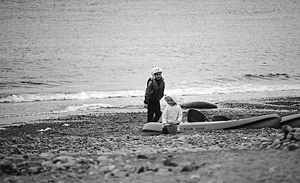
Mendocino shoreline
Photo: Lisa Norman
Mendocino
Highlights: In two words: sea caves. Sea caves litter the Mendocino and Sonoma coast. Where there is no sandy beach, most likely there is a cave or the beginnings of one. Some are little more than shallow depressions or arches, while others are complex tunnels that you can follow hundreds of feet from one rocky cove to another. In some of the more serpentine caves it’s good to have a headlamp. Huge unimpeded northwest swells have pummeled this coast for centuries to create this network of caves. In September and October, the big swells are usually still on vacation, making for one of the best times to explore the caves by kayak. But caution is advised at all times. Novice paddlers should go only with a guide.
But there’s more to see than just caves, as Lost Coast Kayaking guide Craig Comen relates:
“Around me are sandstone cliffs, lined with cypress, pine and redwood. Above me, osprey screech and hover, seeking prey. Below me, sea stars, green anemones, and red abalone lead their sessile lives and thrive in the 55 degree water. It is here I watch pelagic cormorants nest, the young growing each day of summer, and finally taking that leap of faith for their first flight. It is here I get to know harbor seals by their markings and personality, and each pupping season another youngster takes to me like Curious George. They spin and frolic under my boat, come speeding at my paddle and look up at me with compassionate eyes. On these waters, I watch the black oyster catcher scale the rocks, court their mate, and voice their opinions loudly about worldly matters. My terrestrial life floats away as I join the other beings of this habitat and put myself in a different chain of circumstance.”
Another great side trip, but not quite as saline is a quiet paddle up one of the many scenic rivers. Here one can meander with the tidal ebb and flow, and catch a glimpse of otters, harbor seals, egrets, osprey, kingfishers and spectacular redwoods.
Logistics: Approximately 3.5 hours north of San Francisco, Van Damme State Beach is one of the best access points. It offers a sandy south-facing launching beach and convenient parking. Other good put-ins are found at Albion Cove and the Navarro River to the south on Highway 1, and to the north, Fort Bragg’s Noyo Harbor, Russian Gulch and Caspar Beach. A good reference for current conditions and forecasts is NOAA weather radio, especially the bouy reports from Point Arena and Cape Mendocino.
Outfitters: Guided tours are available from two local outfits, Force 10 Ocean Kayak Tours in Elk (www.force10tours.com; 707-937-2434), Blue Water Ventures (www.bluewaterventures.org, 831-459-8548 and Lost Coast Kayaking in Little River (www.lostcoastkayaking.com, 707-937-2434), which offers two-hour guided tours on sit-on-top kayaks for $50 per person.
Other outfitters also lead weekend trips to Mendocino, including Kayak Connection (www.kayakconnection.com) of Santa Cruz. California Canoe & Kayak (www.calkayak.com; 800-366-9804) also has a trip planned to explore Mendocino’s sea caves on Sept. 10-11 ($249 including gear, meals and camping).
Getting there: Take 101 north to Highway 128 west, just north of Cloverdale. Continue west through the vineyards of Anderson Valley until you meet up with Highway 1.

Camping on the beach
Photo courtesy of Blue Waters Kayaking
Tomales Bay/Drakes Estero
Highlights: One of the best year-round paddling destinations on the West Coast, Tomales Bay is a long sliver of a bay on the lee side of the Point Reyes peninsula. It’s wind-sheltered and swell-protected waters, kayak camping on secluded beaches, tremendous bird life and an organic rural ambience, all within in an easy drive of the Bay Area. It’s an ideal place for beginning touring kayakers to try their first overnight trip. Conditions gradually become more challenging as one approaches the more exposed northern part of the bay.
Drakes Estero, on the south-facing sweep of the Point Reyes National Seashore, is another stunning place to paddle in the fall. (It is closed to kayaks from March 15 until July 1.) Surrounded by rolling grassy hills, the estero is rich in wildlife, including harbor seals, bat rays, leopard sharks and a wide variety of birds – osprey, geese, white pelicans, loons, grebes, shorebirds. After launching from Johnson’s Oyster Farm, the only access point, you can paddle 3.5 miles across the estero to Drakes Bay or explore several other fingers of the estero.
Logistics: Follow 101 north to Sir Francis Drake Boulevard and head west to Highway 1. Turn north toward Point Reyes Station and Inverness.
Outfitters: Blue Waters Kayaking (www.bwkayak.com, 415-669-2600) offers guided half-day and full-day tours of Tomales Bay and Drakes Estero. Kayak rentals are available at both of Blue Waters’ Tomales Bay locations: in Inverness on the west side, and in Marshall on the east. Closed-deck kayaks and sit-on-tops are available. To rent closed-deck boats you must have completed a sea kayaking basic skills course or equivalent, and know recovery and re-entry techniques.
Kayak Connection (www.kayakconnection.com), Blue water Ventures (www.bluewaters.org) and Adventure Sports Unlimited (www.asudoit.com) also run overnight trips to Tomales Bay.
Half Moon Bay
Highlights: Wild paddling at the Bay Area’s front door. From protected Pillar Point Harbor, experienced paddlers can venture out to open ocean to explore the rugged coast of the Fitzgerald Marine Reserve, including sea stacks, kelp beds, secluded beaches and the legendary Mavericks surf break (No worries – it breaks only under big winter swells). Inside the harbor breakwater, there’s a mellow three-mile loop tour and some sandy beaches that are good for practicing rescues and other skills. Accomplished adrenaline-seeking surf-ski paddlers frequent Half Moon Bay to ride ocean swell. For short boaters, there are also some good breaking-wave surf spots. As always, use caution, paddle with a buddy, and get proper training before getting in over your head.
Logistics: From the Bay Area, take Highway 92 west to Highway 1 and go north to Pillar Point Harbor. Launching sites include the Half Moon Bay Yacht Club in Princeton, along Highway 1 near Surfer’s Beach, and the beach near the boat ramp.
Outfitters: California Canoe & Kayak (www.calkayak.com, 800-366-9804) Venture Quest kayaks (www.kayaksantacruz.com, 831-427-2267) and Half Moon Bay Kayak Co. (www.hmbkayak.com, 650-773-6101) offer tours and classes. Half Moon Bay Kayak Co. also rents sit-on-tops and closed-deck touring kayaks.
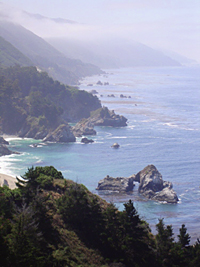
The rugged Big Sur coastline
Photo courtesy of Big Sur Kayak Adventures
Big Sur
Highlights: If you think Big Sur is dramatic from the road, you should see it from a sea kayak. The Santa Lucia Mountains soar above dramatic cliffs to dominate your macro-vision, while at water level you experience the rich sea life of the Monterey Bay National Marine Sanctuary, among the most productive marine habitats on the planet.
The problem that flummoxes most paddlers to this stretch of coast is where to put-in. The protected beach at Andrew Molera State Park is one of the best spots, but you’ll have to carry your boat a mile from the parking lot. The reward – solitude, scenery and good surfing waves – is well worth it. Offshore, otters populate thick kelp beds. Further south, Mill Creek State Beach offers the best access to the southern reaches of Big Sur’s 90-mile coastline, where the mountains surge to more than 5,000 feet above sea level.
Outfitters: Big Sur Kayak Adventures (www.bigsurkayaks.com, 1-888-5BIGSUR) offers single- and multi-day trips from Point Lobos to San Simeon. Daily tours depart from Pacific Valley, Andrew Molera State Park and Point Lobos State Reserve. Santa Cruz-based Kayak Connection (www.kayakconnection.com) leads weekend trips to Big Sur ($125) on Oct. 8-9 and Nov. 5-6.
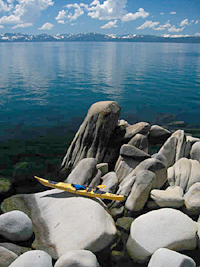
Rocky Tahoe shore
Photo: Paul Vincent Tralka
Lake Tahoe
Highlights: Beautifully clear fresh water surrounded by sandy beaches, granite boulders, forests of pine, alpine peaks and a lot less congestion than in the summer months, Lake Tahoe provides a refreshing alternative to coastal paddling. Many paddlers make it a goal to circumnavigate the lake, approximately 80 miles. Among many spectacular spots, Emerald Bay provides the most dramatic setting. The California state park system maintains 20 boat-in camping sites at Emerald Bay (reservations not accepted after Sept.1).
Outfitters: On the south shore, Kayak Tahoe (www.kayaktahoe.com, 530-544-2311) offers rentals, tours and classes from its shop on the pier at Timber Cove Marina. Tours include Emerald Bay and the Truckee River estuary. Kayaks can be rented overnight for camping at Emerald Bay. On the north shore, Tahoe City Kayak (www.tahoecitykayak.com, 530-581-4336) offers rentals and tours through September before shutting down for the winter.

